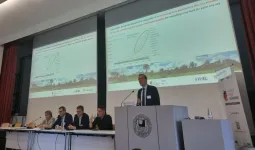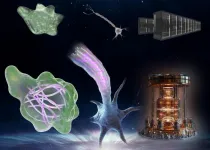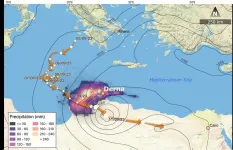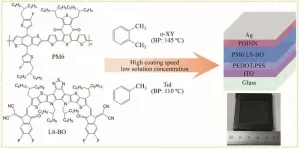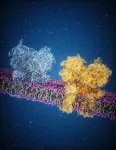(Press-News.org) KENNEDY SPACE CENTER (FL), March 28, 2025 – Heart disease remains the leading cause of death in the United States, accounting for one in five deaths. The inability of damaged heart muscle tissue to regenerate makes heart disease difficult to treat, and end-stage heart failure patients have no choice but to join a long list of people waiting for a heart transplant. Researchers from Emory University are working to provide another option for such patients. To do this, the team took their research to a laboratory unlike any on Earth—the International Space Station (ISSInternational Space Station).
Chunhui Xu and her team leveraged the ISS National Laboratory® for cardiac cell research to accelerate the development of cell-based regenerative therapies that could one day reverse heart damage. Results from these studies have led to multiple peer-reviewed publications, including findings recently published in the high-impact journal Biomaterials. Follow along on Xu’s journey to space-based research in a story featured in the latest issue of Upward, official magazine of the ISS National Lab.
It all began with an eye-opening seminar on science in space and a surprising observation about cancer cells during spaceflight. Researchers found that exposure to microgravityThe condition of perceived weightlessness created when an object is in free fall, for example when an object is in orbital motion. Microgravity alters many observable phenomena within the physical and life sciences, allowing scientists to study things in ways not possible on Earth. The International Space Station provides access to a persistent microgravity environment. increased cancer cell proliferation and survival. Xu hypothesized that heart cells might exhibit similar behavior, which would address two current roadblocks in developing cell-based therapies for heart disease.
After successfully testing the theory in a ground-based study using simulated microgravity, Xu and her team conducted two spaceflight investigations. The first examined how stem cells differentiate into heart muscle cells, while the second looked at the maturation of heart muscle cells into tissue-like structures. Insight gained from the team’s space-based research could significantly advance methods to produce cardiac cells for regenerative therapies, helping to transform the landscape of heart disease treatment.
In the article, Xu says, “The space environment provides an amazing opportunity for us to study cells in new ways. Our research on the ISS could allow us to develop a new strategy to generate cardiac cells more efficiently with improved survival when transplanted into damaged heart tissue, which would greatly benefit patients on Earth.”
about the team’s exciting research in the Upward feature, “Celestial Cells.”
Download a high-resolution image for this release: NASA Astronaut Jasmine Moghbeli
END
Studying cardiac cells in space to repair heart damage on Earth
ISS National Lab-sponsored research is accelerating the development of regenerative therapies that could one day reverse heart damage—learn more in the latest issue of Upward magazine
2025-03-28
ELSE PRESS RELEASES FROM THIS DATE:
Studies evaluate the health effects of bioactive compounds obtained from plants
2025-03-28
Fruits and plant extracts contain bioactive compounds that can help treat or prevent diseases. To characterize and understand their mechanism of action, researchers from universities and research institutions in Brazil and Germany have conducted independent but complementary studies.
Some of the results were presented at a lecture session on the future of food and nutrition research on March 25th during FAPESP Week Germany at the Free University of Berlin.
According to Ulrich Dobrindt, a professor at the University of Munich in Germany, medicinal plants contain different types of phytochemicals (natural ...
Howard University physicist revisits the computational limits of life and Schrödinger’s essential question in the era of quantum computing
2025-03-28
WASHINGTON, DC – (March 28, 2025) More than 80 years ago, Erwin Schrödinger, a theoretical physicist steeped in the philosophy of Schopenhauer and the Upanishads, delivered a series of public lectures at Trinity College, Dublin, which eventually came to be published in 1944 under the title What is Life?
Now, in the 2025 International Year of Quantum Science and Technology, Philip Kurian, a theoretical physicist and founding director of the Quantum Biology Laboratory (QBL) at Howard University in Washington, D.C., has used the laws of quantum mechanics, which Schrödinger postulated, and the QBL’s discovery of cytoskeletal ...
Navigating a US bioscience career despite anticipated cuts in funding for biomedicine
2025-03-28
Many young and midcareer scientists in the U.S. are understandably anxious about potential cuts to government funding and the rise of junk science. Although your future in biomedicine may not be what you originally planned, it might actually become more interesting and filled with new possibilities and opportunities for innovation. Don’t think of this time to hunker down and disappear. Do the opposite with the understanding that you are more powerful and brilliant than you may realize.
In your coverage, please use this URL to provide access to ...
How the failure of two dams amplified the Derna Flood tragedy
2025-03-28
A new study reveals that the devastating 2023 flood in Derna, Libya, was not merely the result of extreme rainfall but was drastically intensified by a major design shortcoming and its resulting collapse of two embankment dams. Through advanced hydrological modeling and satellite data analysis, researchers found that while Storm Daniel brought heavy rainfall, the catastrophe stemmed from dam failures and flawed risk assessment and communication—amplifying the destruction nearly twentyfold. The findings highlight the urgent need for improved flood mitigation strategies, especially in dryland regions where high uncertainty ...
Oral contraceptives and smoking impact steroid hormone levels in healthy adults
2025-03-28
Steroid hormone levels in healthy adults are influenced by oral contraceptives and smoking, as well as other lifestyle choices and factors such as biological sex and age, according to new research that has just been published in leading international journal Science Advances.
The objective of the research was to expand knowledge and understanding of steroid hormone levels, including corticoids and sex hormones, in healthy women and men over a broad age range. This is the first study to analyse such a large number of hormones in nearly 1,000 healthy people, filling a ...
C-Path’s predictive safety testing consortium advances a transformative test to detect drug induced liver injury
2025-03-28
TUCSON, Ariz., March 27, 2025 – Researchers from Critical Path Institute’s® (C-Path) Predictive Safety Testing Consortium have proposed glutamate dehydrogenase (GLDH) as a more liver-specific biomarker for detecting liver injury, supporting clearer decision-making. Currently, alanine aminotransferase and aspartate aminotransferase (ALT and AST) are considered the “gold standard” biomarkers in clinical practice and drug development. However, these biomarkers are not specific to the liver and can reflect changes in other tissues, which may lead to unclear diagnoses, particularly in individuals with muscle conditions ...
Green solvent innovation: high-speed doctor-blading boosts organic solar cell efficiency
2025-03-28
In a recent advancement, researchers have developed a high-speed doctor-blading technique that enhances the efficiency of organic solar cells (OSCs) while using eco-friendly, non-halogenated solvents. This innovative method not only addresses the environmental and scalability challenges of traditional solvents, such as chloroform, but also achieves impressive power conversion efficiencies (PCEs) of 18.20% and 17.36% with green solvents like o-xylene and toluene, respectively. With a module efficiency of 16.07%, this breakthrough sets the stage for more sustainable, ...
C-Path announces successful conclusion of the ECOA: getting better together initiative
2025-03-28
TUCSON, Ariz., March 26, 2025 – Critical Path Institute® (C-Path)Patient-Reported Outcome (PRO) Consortium and Electronic Clinical Outcome Assessment (eCOA) Consortium are pleased to announce the successful conclusion of the eCOA: Getting Better Together Initiative. This initiative, driven by a shared commitment to advancing patient-focused drug development, has culminated in meaningful, lasting changes that will benefit all stakeholders across the eCOA ecosystem.
Beginning in 2019, this C-Path-led collaborative, pre-competitive initiative brought ...
Brain channels ‘stopped in time’ reveal chemical flow that enables learning and thinking
2025-03-28
FOR IMMEDIATE RELEASE
In an effort to understand how brain cells exchange chemical messages, scientists say they have successfully used a highly specialized microscope to capture more precise details of how one of the most common signaling molecules, glutamate, opens a channel and allows a flood of charged particles to enter. The finding, which resulted from a study led by Johns Hopkins Medicine researchers, could advance the development of new drugs that block or open such signaling channels to treat conditions as varied as epilepsy and some intellectual disorders.
A report on the experiments, funded by the National ...
PET imaging confirms direct involvement of dopamine in cognitive flexibility
2025-03-28
Reston, VA (March 16, 2025)—For the first time, scientists have confirmed a neurobiochemical link between dopamine and cognitive flexibility, according to new research published in the March issue of The Journal of Nuclear Medicine. PET imaging shows that the brain increases dopamine production when completing cognitively demanding tasks, and that the more dopamine released, the more efficiently the tasks are completed. Armed with this information, physicians may soon be able to develop more precise treatment strategies for neurological and psychiatric disorders.
Cognitive flexibility is the ability to adapt one’s thinking and behavior appropriately to ...
LAST 30 PRESS RELEASES:
Interaction of climate change and human activity and its impact on plant diversity in Qinghai-Tibet plateau
From addressing uncertainty to national strategy: an interpretation of Professor Lim Siong Guan’s views
Clinical trials on AI language model use in digestive healthcare
Scientists improve robotic visual–inertial trajectory localization accuracy using cross-modal interaction and selection techniques
Correlation between cancer cachexia and immune-related adverse events in HCC
Human adipose tissue: a new source for functional organoids
Metro lines double as freight highways during off-peak hours, Beijing study shows
Biomedical functions and applications of nanomaterials in tumor diagnosis and treatment: perspectives from ophthalmic oncology
3D imaging unveils how passivation improves perovskite solar cell performance
Enriching framework Al sites in 8-membered rings of Cu-SSZ-39 zeolite to enhance low-temperature ammonia selective catalytic reduction performance
AI-powered RNA drug development: a new frontier in therapeutics
Decoupling the HOR enhancement on PtRu: Dynamically matching interfacial water to reaction coordinates
Sulfur isn’t poisonous when it synergistically acts with phosphine in olefins hydroformylation
URI researchers uncover molecular mechanisms behind speciation in corals
Chitin based carbon aerogel offers a cleaner way to store thermal energy
Tracing hidden sources of nitrate pollution in rapidly changing rural urban landscapes
Viruses on plastic pollution may quietly accelerate the spread of antibiotic resistance
Three UH Rainbow Babies & Children’s faculty elected to prestigious American Pediatric Society
Tunnel resilience models unveiled to aid post-earthquake recovery
Satellite communication systems: the future of 5G/6G connectivity
Space computing power networks: a new frontier for satellite technologies
Experiments advance potential of protein that makes hydrogen sulfide as a therapeutic target for Alzheimer’s disease
Examining private equity’s role in fertility care
Current Molecular Pharmacology achieves a landmark: real-time CiteScore advances to 7.2
Skeletal muscle epigenetic clocks developed using postmortem tissue from an Asian population
Estimating unemployment rates with social media data
Climate policies can backfire by eroding “green” values, study finds
Too much screen time too soon? A*STAR study links infant screen exposure to brain changes and teen anxiety
Global psychiatry mourns Professor Dan Stein, visionary who transformed mental health science across Africa and beyond
KIST develops eco-friendly palladium recovery technology to safeguard resource security
[Press-News.org] Studying cardiac cells in space to repair heart damage on EarthISS National Lab-sponsored research is accelerating the development of regenerative therapies that could one day reverse heart damage—learn more in the latest issue of Upward magazine
